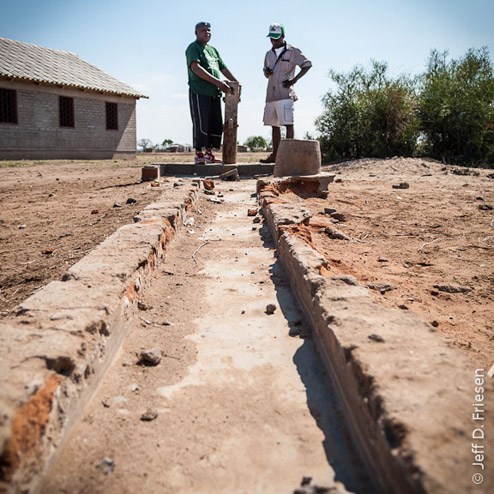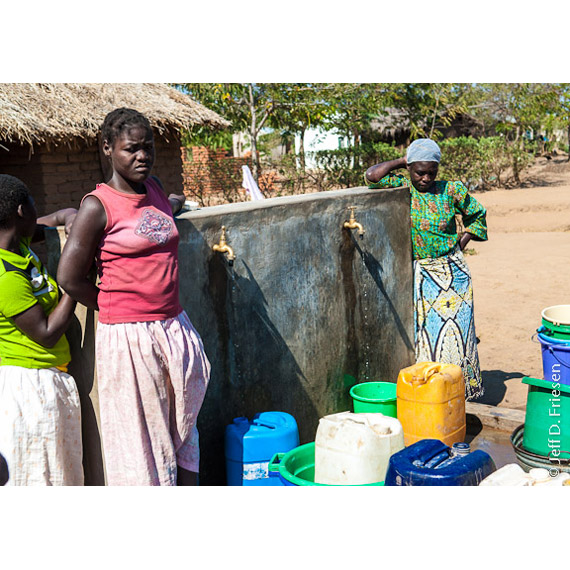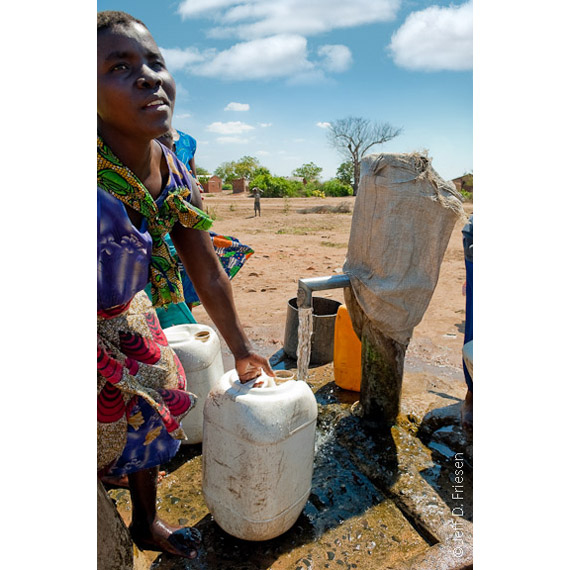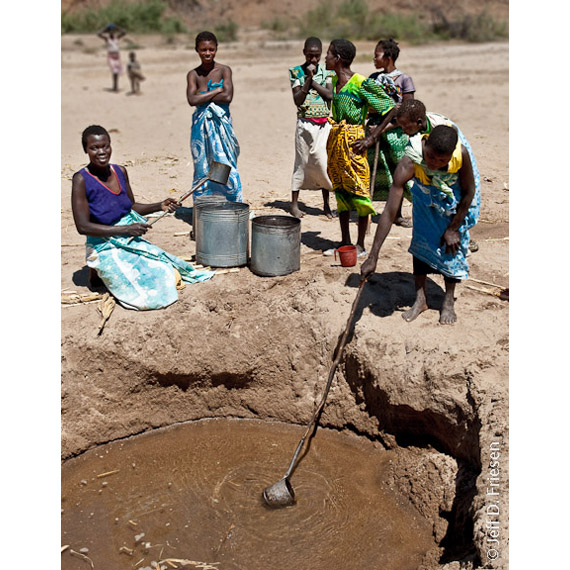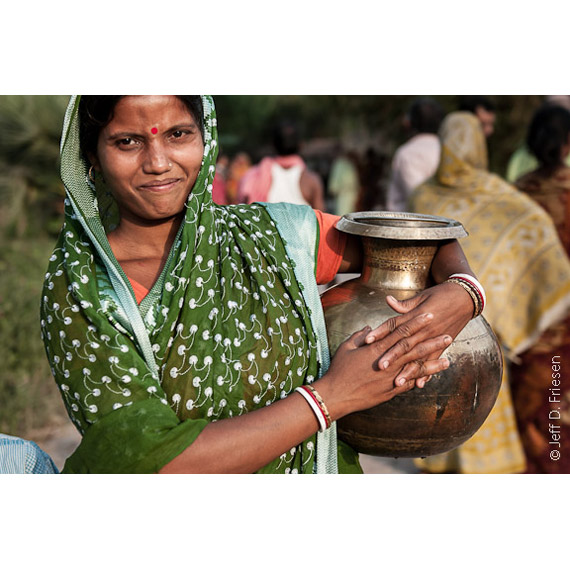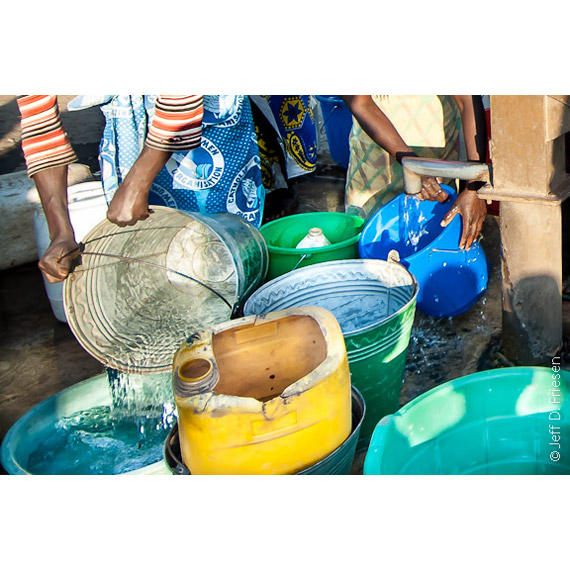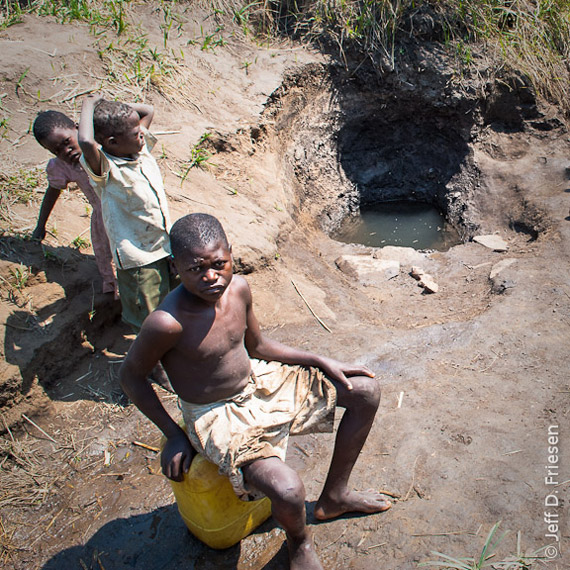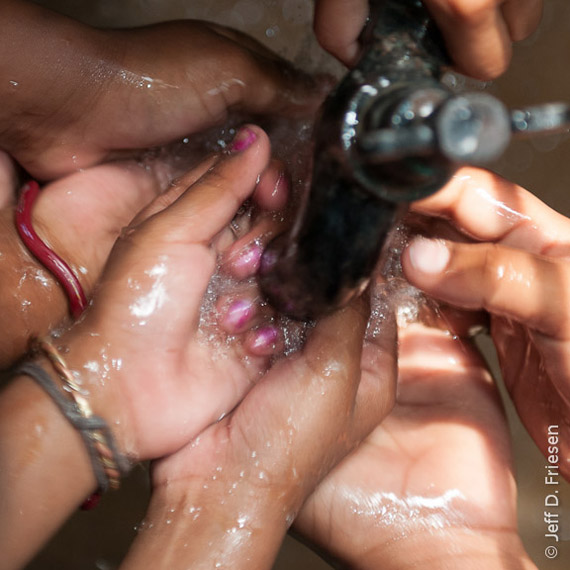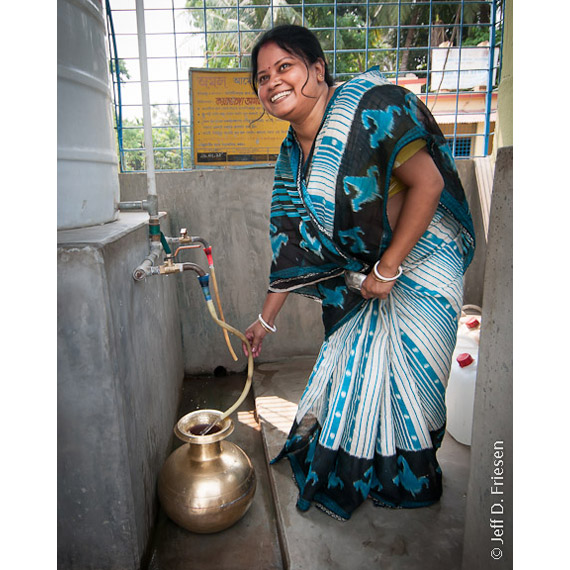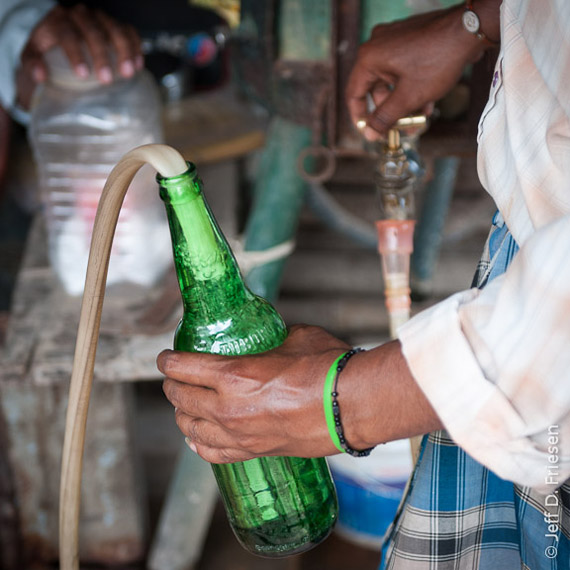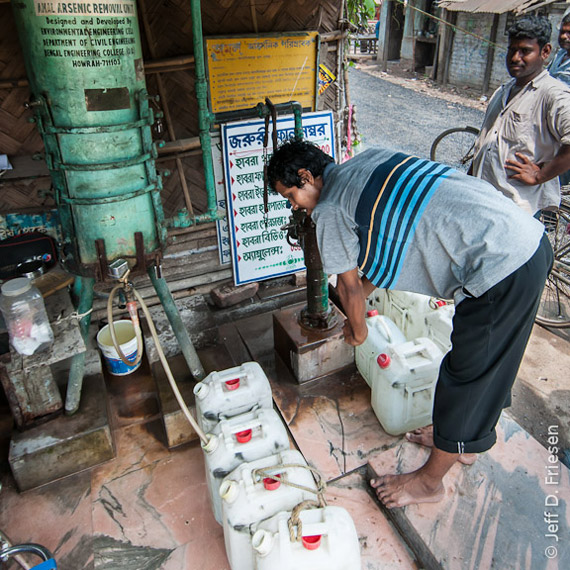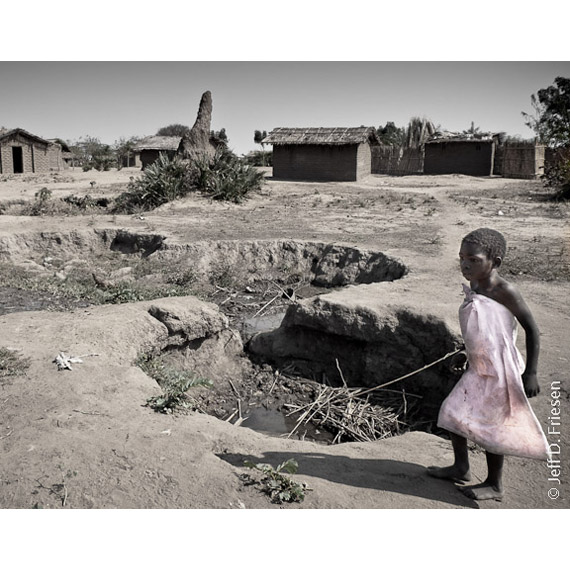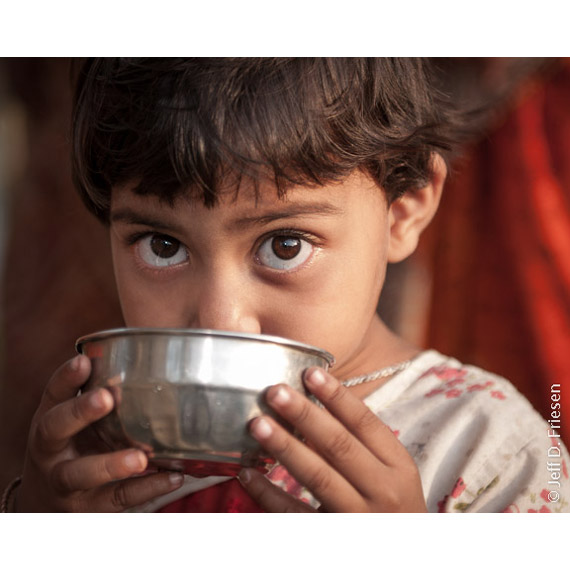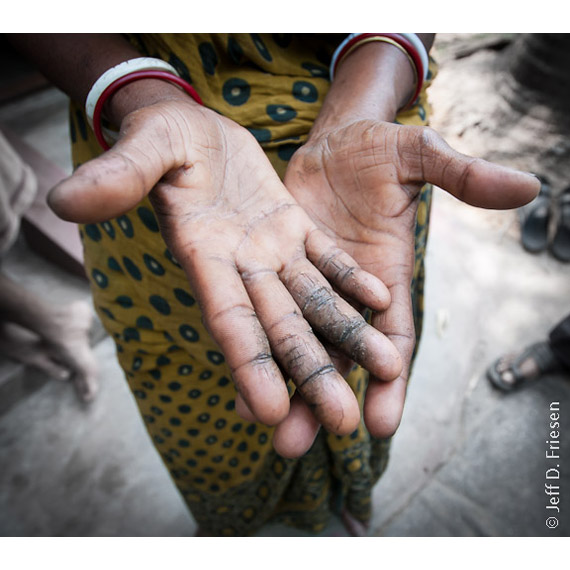Charity Isn’t Enough Moving Toward Sustainable Humanitarian Aid
Mrs. Biba suffers from chronic arsenic poisoning; the signs (thickened, darkened and scaling skin) are clearly visible on her hands. She has been drinking and cooking with arsenic-contaminated water for most of her 42 years in her home village in Ashoknagar, West Bengal, India. The local groundwater has high natural levels of arsenic, and her village is not served by the government supply system. Her community procures its water from the only local source of drinkable water: groundwater wells. In this same village, Mr. Swapan, a member of the village water committee, has lost his father, uncle and brother to arsenic poisoning. In fact, 28 people in this village have died between 1964 and 2006 from arsenic exposure, which can cause cancer, liver failure and other fatal conditions. Even the coconuts on the trees in this village contain concentrations of arsenic so high they can’t be consumed.
However, action has been taken to improve the villagers’ plight. A community arsenic filter was installed in 2006, and the village now has access to arsenic-free drinking water through a joint project between Water For People (a Denver, Colo.-based NGO), the Bengal Engineering and Science University (BESU) and the local water committee that maintains the filter and accompanying infrastructure.
Clean drinking water can break a cycle of illness, poverty and dependence for a family in the developing world. It can move them past the struggle to exist. It can free a woman (through reduced water-gathering time and better health) to learn and apply her skills in ways that give her, her family and community options and hope. It can enable children, especially girls, to attend school instead of missing classes because of water-borne illnesses, daily water duties or lack of a clean uniform. The men can stay healthy enough to work reliably instead of being laid up with bouts of giardia or diarrhea. In these ways and others, clean and accessible water, combined with good sanitation and hygiene practices, can provide options where few previously existed. A woman, a family, a community and a society can then rise above the patterns of life that leave them without choices and force them to depend on the benevolence of others. The greatest challenge, once this is achieved, is to maintain it indefinitely, thereby eliminating the recurring need for charitable intervention.
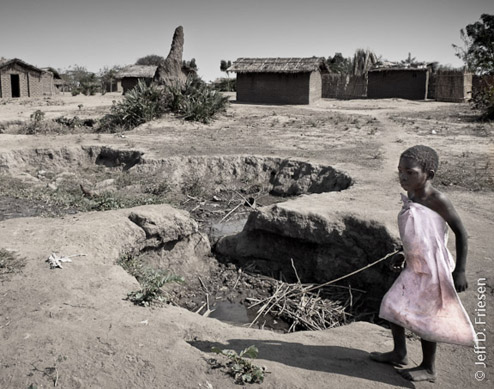
.
Solving water and wastewater (sewage) problems is a big part of what I do as a Civil Engineer.
Engineering is the process of translating science into real world solutions. For example, finite element computer models become soaring structures that are safe and economical, and chemical and biological equations drive water treatment processes and systems designed to provide safe drinking water to millions of people, a small community or a school. Civil Engineering is all about providing essential infrastructure for a society. Think of roads, sewers, water supply, electricity distribution, large structures, flood forecasting and planning, and solid waste management. But seldom are problems addressed at the individual level in my line of work. I miss the human connection when dealing with design and planning work; individuals are lost in abstract aggregations of supply and demand populations.
The individual connection is real and immediate, however, when working to understand and to promote water, sanitation and hygiene solutions in communities and households in the developing world. Going door-to-door in remote impoverished communities to interview and to listen to women and men talk about their water, sanitation and hygiene practices and problems quickly dismantles any abstract separation between me and those I’m there to serve. Priorities of life become jarringly apparent and immediate when we sit and talk with families in need and hear their stories.
Sometimes the water quality at a remote water source is fine, but the quantity is inadequate. In a remote village in Nchalo, Chickwawa District, Malawi, women wait to fill their large containers from two thin threads of water (barely visible in the photo – see slide show) coming from taps in the community water kiosk. The women in this queue will wait two to three hours to fill their containers with one day’s supply of water. Add to that a walk of perhaps an hour, and it’s easy to see why girls miss school and why women can find it so hard to escape the cycle.
In the developing world, public infrastructure is often non-existent in the lives and experiences of the majority of the populations. Because of this, most people do not have access to clean drinking water, adequate sanitation (toilet facilities) and education about hygiene practices to minimize common waterborne and communicable diseases. Governments may be indifferent or may not have the resources or skills to build and to provide the needed services. Charitable organizations by the hundreds work hard, with varying degrees of success, to fill the gaps.
Despite the struggles of life in these places, I’m repeatedly struck by how easily the people smile and laugh, and offer gracious hospitality to strangers about whom they often have little understanding. What I believe they recognize instantly is what we have in common – that we, like them, are people with families we love, and that we need to eat, drink, work and get through the day just as they do. My experience is that we, with our western perceptions, initially see the opposite – we see what sets us apart: differences in clothing, material wealth, education, hygiene and access to services.
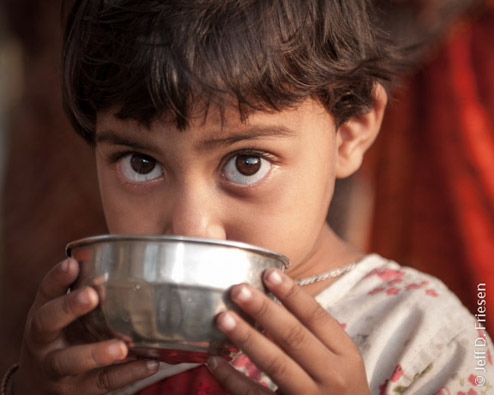
.
When we move past the differences on the surface, we can focus on the hope they often express in the future – generally through faith combined with tenacious resourcefulness. Sometimes, though, I see and hear frustration resulting from broken promises. One man in a Malawi community asked me (through a translator) what we were going to do for them and whether we were just going to promise (and then not deliver) more solutions like other foreigners had done before us.
Solutions to the often urgent needs for water seem deceptively simple. Often there aren’t enough hand pumps, or they are too far away from the individual homes. The traditional solution? Bore a well and put in a hand pump! This can be very appealing to all involved: The community is happy to have water it desperately needs; the contributing charity organization is addressing a real need; the donors have the satisfaction of seeing something quantifiable done with their contributions, and the pressure is off the government (at least temporarily). But this success is usually short-lived.
Here’s where the complexity surfaces. A single, unsupported hand pump doesn’t work in the long term, or in other words, the solution is not sustainable if it comes as charity and is not implemented and driven from within the community. There’s no sense of ownership by the community and no investment of work or money. With no community oversight of this new shared resource, no one takes responsibility for care and upkeep. When the pump fails – and it will fail – it sits in disrepair or is cannibalized for parts, awaiting another gift of charity. This perpetuates reliance on the charity model, which cannot be sustained. What happens when the charity stops? The clean water stops. I have witnessed the futile results of this process countless times. So what are these well-meaning benefactors doing wrong?
Short-term solutions often contribute to cycles we want to break. A pump hastily installed may not be deep enough to pull water from a cyclical water table, so the pump goes dry during the dry season. I have visited numerous pumps that produced enough water for the community but from the first day of operation the water was too saline to drink. Uncoordinated hand pump installations by the many aid organizations that operate in these countries may have only passive support from the local governments, thus leaving communities to fend for themselves when pumps no longer work. With no local parts supply chain and no community water committee to collect and manage repair and maintenance funds, purchase parts, ensure skilled repair mechanics and care for the facility, pumps fail in every way. We need a different model for long-term success.
A truly successful solution must consider what the community needs throughout a period of years and how funding and markets that enable continued operation can be sustained so charity inputs can be withdrawn and focused elsewhere. The oft-cited parable tells us to teach a man to fish for life rather than to give a fish for only one meal. I want to see communities lift themselves up and develop their own resources and skills so their continuing success comes from within, not from external charity. Of course, what I want doesn’t matter to these communities, but what I want echoes what we’ve heard from individuals and leaders in hundreds of communities in Rwanda, Malawi and West Bengal (the countries I’ve worked in). I’m not saying it’s easy or fast, but it works.
So how does a working solution evolve? I will summarize, in my own words, what Water For People does. I agree with their sustainable approach, which is why I’ve donated more than eight weeks of my time to leading and working on their in-country volunteer assignments. Although I am focusing on water, this approach can apply across all sectors.
- Listen to what communities want and need; make the solution community-driven.
- Employ in-country staff who know and can work within the local and regional political systems.
- Find effective and trusted in-country partner organizations (that already work within the communities) to manage implementation of solutions on the ground.
- Instill a sense of ownership in the communities by requiring investment and commitment in whatever currency is mutually workable: labor, materials, land, facilities or money.
- Find or create necessary local markets to make the solution self-sustaining.
- Develop education and training materials as needed.
- Monitor what has worked and what has not worked; learn from this and change accordingly.
- Expand the working solutions by replicating the approach in other communities.
The final measure of success is to remove charitable contributions all together and have the system sustain itself. Admittedly this can take years to succeed as trust and relationships are developed. Of course, once successes are achieved and local support systems are in place, recreating successes in adjacent communities becomes easier.
This long-term approach is a much harder sell for donors, but it is catching on. It’s entirely understandable that donors want to see something built with their funds in short order– something physical that does immediate good and relieves human suffering. But I believe that a sustainable, longer-term model in which a community ultimately sustains its own services will give the people we want to help, and us, the greatest possible success.










